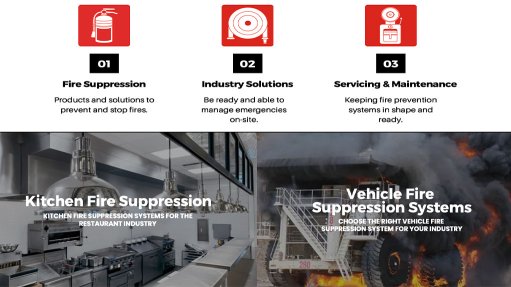Often-overlooked duplex stainless steels better for corrosion resistance
Duplex stainless steels, which have a higher chromium content and lower nickel content, are more resistant to pitting and can withstand higher temperatures, which make them a viable solution to unique applications that have a higher likelihood of pitting, says Chemical Corrosion Services consultant Simon Norton.
Speaking during a webinar hosted by Creamer Media on the Essentials of Stainless Steel, held on August 26, he pointed out that stainless steels are a family of passive alloys that contain chromium and form a passive top or chrome oxide layer.
“This is the heart of the secret of stainless steel,” he said.
The family of stainless steels are split into five groups, including austenitic (non-magnetic), whose structure is face-centred cubic; ferritic, whose structure is body-centred cubic; duplex (magnetic), which consists of 50% austenitic and 50% ferritic; martensitic, whose structure is body-centred tetragonal; and precipitation hardened, whose structure is martensitic, austenitic or semi-austenitic.
However, Norton stated that few engineers seemed to know about duplex stainless steels, which could be very useful in various applications.
With a focus on austenitic and duplex stainless steels, he says 304 stainless steels typically contain iron, 0.04% carbon, 18% chromium and 8% nickel, while 316 stainless steels typically contain iron, 0.04% carbon, 17% chromium, 10% nickel and 2% molybdenum.
In terms of duplex stainless steels, the 2205 variants contain iron, 0.02% carbon, 22% chromium, 5.7% nickel and 3% molybdenum.
The super austenitic 904 L stainless steels contain iron, 0.01% carbon, 20% chromium, 25% nickel, 4% molybdenum and copper.
“Many people I come across implement the 316 stainless steel without realising they should use the 316 L, which stands for low-carbon and benefits applications that use welding,” said Norton, adding that the duplex 2205 stainless steel was a “completely different material”.
He explained that the main corrosion types associated with stainless steel included pitting corrosion, crevice corrosion (localised corrosion), stress corrosion and cracking and intergranular corrosion.
“Stainless steel is a strange material. Unlike normal mild or carbon steel, which rusts uniformly, stainless steel, and in particular stainless steel piping, can be very deceptive. There will be no uniform corrosion. Suddenly a pit will develop and when that happens you can expect catastrophic failure,” said Norton.
Further, he said austenitic stainless steel could not be hardened by heat treatment and had to be hardened by cold working.
“This stainless steel has good formability and weldability and is reasonably good in terms of corrosion resistance.”
Norton said that ferritic stainless steel could also not be hardened by heat treatment, but had good formability characteristics and drawability. “It’s corrosion resistance is not as good as austenitic, but it does have stress-corrosion cracking resistance.”
Meanwhile, duplex stainless steels, which he suggested engineers start looking at, were “enormously useful materials”.
He explained that, for the same thickness of austenitic 304 or 316, the duplex stainless steels offered the same characteristics at a much lower thickness and achieved better performance.
According to him, the difference between ferritic and austenitic stainless steels lies in the fact that ferritic stainless steels have atoms at each end of the cubic structure, as well as one in the middle; while austenitic stainless steels have atoms at each end, as well as in the middle of each face of the cubic structure.
“These different characteristics are vital to the performance of these products with respect to their mechanical strength and corrosion resistance.”
He introduced a seldom-referred-to principle of pitting resistance equivalent number (pren), which can be used as a comparative tool for selecting stainless steel.
According to the pren, Norton said, the presence of chromium acted as a ferrite stabiliser, while nickel acted as a austenite stabiliser. Molybdenum increases pitting resistance and nitrogen increases pitting resistance and adds strength.
In terms of pitting corrosion, he said this form was very dangerous.
“This forms when the passive layer is broken and a pit begins to form. It looks very small at first, but the volume of the pit under the surface can be enormous.
"That can lead to catastrophic failure of the structure,” he said, adding that, in some instances, the use of duplex stainless steels could overcome pren challenges.
Article Enquiry
Email Article
Save Article
Feedback
To advertise email advertising@creamermedia.co.za or click here
Comments
Announcements
What's On
Subscribe to improve your user experience...
Option 1 (equivalent of R125 a month):
Receive a weekly copy of Creamer Media's Engineering News & Mining Weekly magazine
(print copy for those in South Africa and e-magazine for those outside of South Africa)
Receive daily email newsletters
Access to full search results
Access archive of magazine back copies
Access to Projects in Progress
Access to ONE Research Report of your choice in PDF format
Option 2 (equivalent of R375 a month):
All benefits from Option 1
PLUS
Access to Creamer Media's Research Channel Africa for ALL Research Reports, in PDF format, on various industrial and mining sectors
including Electricity; Water; Energy Transition; Hydrogen; Roads, Rail and Ports; Coal; Gold; Platinum; Battery Metals; etc.
Already a subscriber?
Forgotten your password?
Receive weekly copy of Creamer Media's Engineering News & Mining Weekly magazine (print copy for those in South Africa and e-magazine for those outside of South Africa)
➕
Recieve daily email newsletters
➕
Access to full search results
➕
Access archive of magazine back copies
➕
Access to Projects in Progress
➕
Access to ONE Research Report of your choice in PDF format
RESEARCH CHANNEL AFRICA
R4500 (equivalent of R375 a month)
SUBSCRIBEAll benefits from Option 1
➕
Access to Creamer Media's Research Channel Africa for ALL Research Reports on various industrial and mining sectors, in PDF format, including on:
Electricity
➕
Water
➕
Energy Transition
➕
Hydrogen
➕
Roads, Rail and Ports
➕
Coal
➕
Gold
➕
Platinum
➕
Battery Metals
➕
etc.
Receive all benefits from Option 1 or Option 2 delivered to numerous people at your company
➕
Multiple User names and Passwords for simultaneous log-ins
➕
Intranet integration access to all in your organisation


















